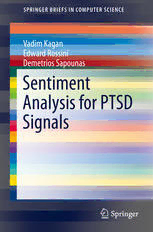Table Of ContentSpringerBriefs in Computer Science
Series Editors
Stan Zdonik
Peng Ning
Shashi Shekhar
Jonathan Katz
Xindong Wu
Lakhmi C. Jain
David Padua
Xuemin Shen
Borko Furht
V. S. Subrahmanian
Martial Hebert
Katsushi Ikeuchi
Bruno Siciliano
For further volumes:
http://www.springer.com/series/10028
Vadim Kagan (cid:129) Edward Rossini
Demetrios Sapounas
Sentiment Analysis
for PTSD Signals
Vadim Kagan Edward Rossini
SentiMetrix©, Inc. Roosevelt University
Bethesda , MD , USA Chicago , IL , USA
Demetrios Sapounas
Center for International Rehabilitation
Washington , DC , USA
ISSN 2191-5768 ISSN 2191-5776 (electronic)
ISBN 978-1-4614-3096-4 ISBN 978-1-4614-3097-1 (eBook)
DOI 10.1007/978-1-4614-3097-1
Springer New York Heidelberg Dordrecht London
Library of Congress Control Number: 2013951647
© The Author(s) 2013
This work is subject to copyright. All rights are reserved by the Publisher, whether the whole or part of
the material is concerned, specifi cally the rights of translation, reprinting, reuse of illustrations, recitation,
broadcasting, reproduction on microfi lms or in any other physical way, and transmission or information
storage and retrieval, electronic adaptation, computer software, or by similar or dissimilar methodology
now known or hereafter developed. Exempted from this legal reservation are brief excerpts in connection
with reviews or scholarly analysis or material supplied specifi cally for the purpose of being entered and
executed on a computer system, for exclusive use by the purchaser of the work. Duplication of this
publication or parts thereof is permitted only under the provisions of the Copyright Law of the Publisher’s
location, in its current version, and permission for use must always be obtained from Springer.
Permissions for use may be obtained through RightsLink at the Copyright Clearance Center. Violations
are liable to prosecution under the respective Copyright Law.
The use of general descriptive names, registered names, trademarks, service marks, etc. in this publication
does not imply, even in the absence of a specifi c statement, that such names are exempt from the relevant
protective laws and regulations and therefore free for general use.
While the advice and information in this book are believed to be true and accurate at the date of
publication, neither the authors nor the editors nor the publisher can accept any legal responsibility for
any errors or omissions that may be made. The publisher makes no warranty, express or implied, with
respect to the material contained herein.
Printed on acid-free paper
Springer is part of Springer Science+Business Media (www.springer.com)
Acknowledgments
The authors of this publication would like to thank the project team. Key team
members include Arman Anwar, Leslie Barrett, Bethanne Bond, Patrick Brannelly,
Lee Deneault, Deborah Ervin, Shahid Faruqi, Kathryn Jackson, Dr. Jeffrey Kunka,
Dr. Jeri Morris, Michelle Parish, Diego Reforgiato, Andrew Stevens, V.S.
Subrahmanian, Jay Thomas, and Dr. Peter Yellowlees. Without their participation
and contributions, this work would not have been possible.
v
Abbreviations
ADL Activities of Daily Living
APA American Psychiatric Association
API Application Programming Interface
AVA Adjectives, Verbs and Adverbs
CEWS Community for Education, Wellness and Support
CGM Consumer-Generated Media
COTS Commercial off-the-shelf
DSM Diagnostic and Statistical Manual of Mental Disorders
DSM-IV-TR Diagnostic and Statistical Manual of Mental Disorders fourth
edition—Text Revision
DSM-V Diagnostic and Statistical Manual of Mental Disorders fi fth edition
EMR Electronic Medical Record
HA Human Annotation
LDA Latent Dirichlet allocation
MCMI-III Millon Clinical Multiaxial Inventory-III
MMPI-2 Minnesota Multiphasic Personality Inventory—fi rst revision
NLP Natural Language Processing
OEW Opinion-Expressing Word
PII Personal Identifying Information
PIL Psychological Information Library
PTSD Post-Traumatic Stress Disorder
SA Sentiment Analysis
TAT Thematic Apperception Test
TBI Traumatic Brain Injury
VA Veterans Administration
vii
Contents
1 Introduction ............................................................................................... 1
1.1 The Problem ...................................................................................... 1
1.2 PTSD and the Military ....................................................................... 2
1.3 Technology for PTSD ........................................................................ 3
1.4 Project Overview ............................................................................... 4
1.5 Book Outline...................................................................................... 5
References .................................................................................................. 6
2 Introduction to PTSD Signals .................................................................. 7
2.1 Introduction ....................................................................................... 7
2.2 Developing an Etymology of Terms for PTSD ................................. 11
References .................................................................................................. 13
3 Data Sources .............................................................................................. 15
3.1 Introduction ....................................................................................... 15
3.1.1 Psychological Information Library (PIL) ............................. 16
3.1.2 Brain Fitness Free Text Questions ........................................ 17
3.1.3 Social Media—Blogs and Forums ........................................ 18
4 Text Analytics ............................................................................................ 21
4.1 Introduction ....................................................................................... 21
4.2 Application to a Particular Field: Psychology/PTSD ........................ 23
4.3 PTSD Data ......................................................................................... 24
4.4 Procedures and Methods in Data Analysis ........................................ 25
4.5 Performance and Best Practices ........................................................ 26
4.6 Human Annotation ............................................................................ 27
4.6.1 Likelihood of PTSD Syndrome ............................................ 28
4.6.2 Frequency/Intensity of Symptoms ........................................ 29
4.7 Human Annotation Results ................................................................ 30
References .................................................................................................. 32
ix
x Contents
5 Scoring Engine .......................................................................................... 33
5.1 Introduction ....................................................................................... 33
5.2 SentiGrade™ ..................................................................................... 34
5.3 SentiGrade™ Architecture ................................................................ 34
5.3.1 Architecture Diagram ............................................................ 35
5.3.2 Functional Architecture ........................................................ 35
5.3.3 Physical Architecture ............................................................ 38
5.4 SentiMetrix© API ............................................................................... 38
5.4.1 Architecture ........................................................................... 39
5.4.2 API Architecture Diagram .................................................... 39
5.4.3 Opinion Expressing Constructs ............................................. 40
5.5 Modifi cations Needed for the PTSD Domain.................................... 42
5.5.1 Ontology ............................................................................... 42
5.5.2 TAPIR ................................................................................... 43
References .................................................................................................. 49
6 System Overview ....................................................................................... 51
6.1 Overall Architecture .......................................................................... 51
6.2 SentiGradeTM Environment ................................................................ 52
6.3 SentiMetrix© API ............................................................................... 53
6.3.1 API Technologies Used ......................................................... 53
6.3.2 Design ................................................................................... 54
6.3.3 API Interfaces ....................................................................... 55
6.3.4 Text Analysis Data Flow ....................................................... 61
6.4 Dashboard .......................................................................................... 61
6.4.1 Filters .................................................................................... 61
6.4.2 Landing Page ........................................................................ 62
6.4.3 Population Page .................................................................... 63
6.4.4 User Listing Page .................................................................. 63
6.4.5 User Detail Page ................................................................... 65
6.4.6 User Comparison Page .......................................................... 65
7 Conclusions ................................................................................................ 67
7.1 Data Set and Human Annotation ....................................................... 68
7.2 Suggested Evaluation Methodology .................................................. 70
7.3 HA Validation Results ....................................................................... 71
7.4 User Testing and Results ................................................................... 72
7.4.1 Brain Fitness Analysis Results.............................................. 74
7.4.2 Text Analysis Results ............................................................ 77
7.5 Future Work ....................................................................................... 78
7.5.1 Testing and Analyses ............................................................ 78
7.6 Concluding Remarks ......................................................................... 81

